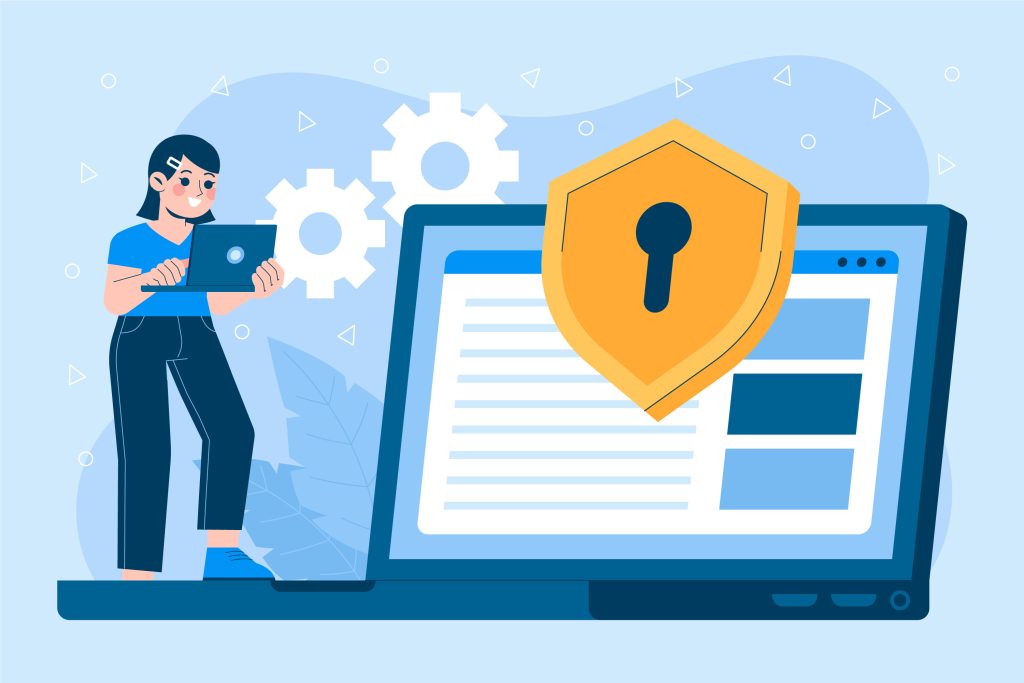
Crafting a GDPR-Compliant Privacy Policy for Ecommerce Businesses
As an ecommerce business owner, you’re likely aware of the importance of protecting your customers’ data. Creating a privacy policy for ecommerce website is not just a legal requirement; it’s a crucial step to build trust with your customers and comply with data protection regulations. We understand that GDPR compliance can be tricky, and that’s why we’re here to assist you throughout the entire process.
Overview of GDPR Compliance
The General Data Protection Regulation (GDPR) has brought about a significant shift in how we handle personal data. Since its introduction in 2018, it has set new standards for data protection and privacy rights for individuals within the European Union (EU) and beyond, including Iceland, Norway, and Liechtenstein.
Impact on Ecommerce Businesses
For us in the ecommerce industry, GDPR compliance is not just a legal requirement; it’s a crucial aspect of our daily operations. We process a substantial amount of data every day, and the GDPR was introduced in response to customer concerns about unwanted marketing campaigns.
To stay GDPR-compliant, we need to:
1. Change our cookie policy from opt-out to opt-in
2. Ensure our third-party services are also GDPR-compliant
3. Assign specific people with access to data
4. Have a dedicated data protection officer
While these changes might seem challenging at first, they present an opportunity for businesses that play by the rules. Four years after its introduction, many experts believe that GDPR benefits companies that adhere to its principles.
Legal Requirements Under GDPR
To comply with GDPR, we must adhere to several key principles:
1. Lawful, transparent, and fair data processing
2. Processing data for specific, known purposes
3. Keeping personal data secure
4. Collecting only necessary information
5. Not storing personal data longer than necessary
6. Maintaining accuracy of retained personal information
Additionally, we need to demonstrate accountability in our data protection practices and keep records of our compliance efforts.
To help ensure our ecommerce business remains GDPR compliant, we should:
1. Regularly map the personal data we hold
2. Conduct updated data protection and privacy training for all employees
3. Have procedures in place for handling Data Subject Access Requests (DSARs)
4. Be prepared to undertake Data Protection Impact Assessments (DPIAs) when necessary
5. Appoint a representative in the EEA if we offer goods and services to EEA citizens
6. Ensure we have written contracts with any data processors we engage
It’s crucial to remember that GDPR applies to all businesses selling goods and services to European citizens, regardless of their location. Non-compliance can result in severe penalties, including fines of up to 4% of annual global turnover or €20 million (£17.5 million in the UK), whichever is greater.
Essential Elements of a GDPR-Compliant Privacy Policy
Types of Data to Include
When crafting a GDPR-compliant privacy policy for our ecommerce website, we need to be thorough in outlining the types of data we collect. This includes personal information such as names, ages, email addresses, IP addresses, delivery addresses, and credit card information. We also need to account for customer preferences, purchasing history, browsing habits, and navigation patterns.
It’s crucial to be transparent about the information we collect both directly and indirectly. Direct collection might happen through opt-in forms or shopping cart checkouts, while indirect collection could involve monitoring browser clicks, time spent on pages, and ad interactions.
Roles and Responsibilities
Under GDPR, we have specific roles and responsibilities when it comes to data protection. As ecommerce business owners, we’re likely to be considered “controllers” – the entities that determine the purposes and means of processing personal data. Our key responsibility is to be accountable, taking actions in line with GDPR and being able to explain our compliance to data subjects and Supervisory Authorities when required.
If we use third-party services to process data on our behalf, they’re considered “processors.” We need to ensure we have written agreements with these processors, outlining their responsibilities in protecting user data.
Transparency and User Consent
Transparency is a cornerstone of GDPR compliance. We need to clearly state what information we’re collecting and explain the specific purpose for collecting each type of data. This includes being upfront about how we use cookies and tracking technologies, as well as how we use data for analytics and advertising purposes.
User consent is another crucial element. We need to establish a process for gathering specific, informed, freely given, and unambiguous consent from visitors for collecting personal data. It’s important to note that “silence, pre-ticked boxes or inactivity should not constitute consent”. We should also provide users with the ability to withdraw their consent at any time.
Data Protection Measures
To comply with GDPR, we need to implement appropriate security measures to protect the data we collect. This includes using updated security systems such as firewall software, apps, or antivirus software. We should also limit data collection to the minimum necessary to fulfill a specific purpose.
In case of personal data breaches, we’re required to report them to supervisory authorities within 72 hours. It’s also our responsibility to ensure that any third-party services we use are GDPR-compliant.
GDPR compliance isn’t just about avoiding penalties – it’s about respecting our customers’ privacy and demonstrating our commitment to responsible data handling.
Creating and Implementing a GDPR Privacy Policy
To create and put into action a GDPR-compliant privacy policy for our ecommerce website, we need to follow a structured approach. Let’s go through the essential steps:
Step 1: Conduct Data Audit
We start by carrying out a thorough data audit. This process helps us identify all the personal data our website collects, processes, and stores. We need to map out:
1. What personal data we’re processing
2. How we’re processing it
3. Whether we need to process it
4. Whether we’re processing it lawfully
It’s crucial to consider all possible entry points for personal data, such as:
| Emails and physical mail | Apps |
| Websites | Third parties |
| Analytics logs | Social media |
| Cookies | Feedback/research surveys |
We should also think about where personal data might be stored within our company, including electronic form on physical devices, cloud servers, and physical form.
Step 2: Draft Clear Privacy Statements
Once we have a clear understanding of our data processing activities, we need to create a clear and concise privacy policy. This policy should:
1. Use simple and understandable language
2. Clearly state what personal data we collect
3. Explain how we use the data
4. Disclose who we share it with
5. Specify how long we keep it
Our privacy policy should also inform users of their rights under GDPR and provide information on how to exercise these rights. We need to make sure our privacy policy is easily accessible on our website.
Step 3: Setup Consent Mechanisms
Obtaining valid consent is a crucial aspect of GDPR compliance. We need to:
1. Ensure consent is freely given, specific, and informed
2. Provide an easily accessible link to our privacy policy
3. Offer an option to agree to the terms and conditions
4. Avoid pre-ticked boxes (they’re forbidden under GDPR)
5. Make it easy for customers to withdraw their consent
Step 4: Train Employees
It’s essential that our staff is aware of data protection measures. We should:
1. Develop guidelines for team members on email security, setting strong passwords, two-factor authentication, device encryption, and the use of virtual private networks (VPNs)
2. Conduct training on GDPR principles each time newcomers join our team and after regulations are updated
3. Pay special attention to those who have direct access to users’ personal data
The EU General Data Protection Regulation (GDPR) requires workforce privacy awareness training. This training should focus on teaching employees what to do to protect personal data, respect people’s rights, and fulfill the obligations of GDPR.
Step 5: Monitor Compliance
GDPR compliance is an ongoing process. We need to:
1. Stay informed about GDPR updates and regulatory changes
2. Regularly review and update our privacy policies and practices
3. Implement appropriate technical and organizational measures to ensure data security
4. Consider appointing a Data Protection Officer (DPO) to oversee compliance efforts
By following these steps, we can create and implement a GDPR-compliant privacy policy for our ecommerce website. This not only helps us avoid potential legal issues but also builds trust with our customers by demonstrating our commitment to protecting their personal data.

Conclusion
Implementing a good privacy policy is an ongoing process that requires regular updates and employee training. It’s not just about avoiding penalties; it’s about respecting customer privacy and demonstrating responsible data handling. By taking these measures, ecommerce businesses can create a secure environment for their customers and gain a competitive edge in the digital marketplace.
Reach out to our team at GDPRLocal for more information.
FAQs
How can I develop a GDPR-compliant privacy policy?
Your privacy policy should be written in clear, comprehensible language. It is essential to state your legal grounds for processing personal data, disclose the rights users have under the GDPR, and inform users about the duration of data retention.
What are the essentials for crafting a privacy policy for an ecommerce store?
When drafting a privacy policy for your ecommerce store, aim to achieve four main objectives: inform visitors about the types of personal data you collect and manage, provide options for users to give or withdraw consent, and allow access to their personal information collected by you and any third parties.
What are the GDPR requirements for ecommerce websites?
Ecommerce sites must obtain user consent before collecting data, which includes providing clear opt-in methods and straightforward opt-out mechanisms in your cookie banner.
What steps should I take to establish a GDPR compliance program?
To implement GDPR, start by cataloging personal data and identifying sensitive data categories. Review and audit data processing activities, update consent forms, and establish a record-keeping system. Designate leaders for GDPR compliance, draft a comprehensive data privacy policy, and ensure that all third-party partners adhere to GDPR standards.